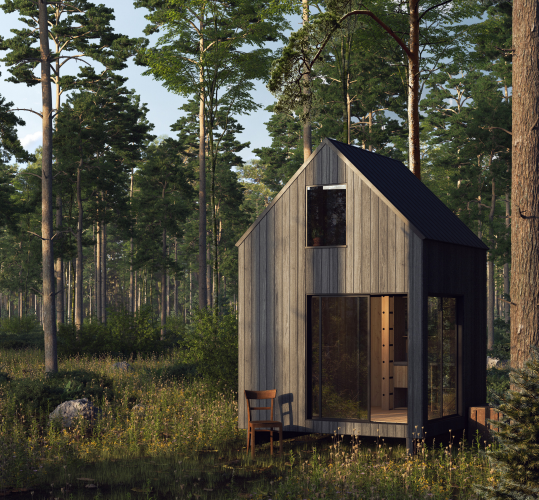HUTS ADUs: Styling Your Space
Although your ADU will have a small footprint, it is sure to have a big
Read more
You are one step closer to creating a little space of your own! Read on to find answers to all of our most frequently asked questions about the HUTS ADU plans.
Very. Our construction documents include exterior and interior details designed and vetted by our licensed architectural team, engineers and consulting contractors. We include comprehensive construction details for framing, insulation, siding, roofing, window and door installation, stove and ventilation, interior millwork, and everything else that goes into the construction of your HUTS ADU.
Yes. The Cottage, Entertainer and Bunkhouse are all designed for a full bathroom with toilet, shower and sink for both on-grid and off-grid configurations. The Little Cottage is designed for a toilet, sink, and outdoor shower.
We think so. The cost of our plans represent +/- 4% of the total construction cost. They are designed by our truly world-class architectural team that cut their teeth at Pritzker-prize winning architectural firms before focusing on small scale design and construction with HUTS.
Our construction documents are the primary guidance, for both you and your build team. The plans are detailed with comprehensive notes. We’ll be able to field select questions submitted to adu@huts.nyc and offer a complimentary review call. Due to volume, further architectural or contractor guidance will be limited and assessed on a per need basis.
Our ADUs are designed for harsh conditions, with insulating properties that are sufficient for the high peaks of the Adirondacks, where temperatures throughout the year can swing by as much as 130 degrees Fahrenheit. In all likelihood, you live in a much more temperate environment, and our ADU designs are over-engineered for those conditions.
All plan sales are final and we’re unable to accept returns and provide refunds. Once we deliver the plans digitally and physically, they’re yours to build according to our terms of use and licensing agreement.
We’ve engineered systems designs for both on- and offgrid living situations. Our preferred product specifications for power, climate, water and waste are included in every set of plans.
For our ADUs, we don’t offer customization services. We also do not provide source design files for our plans. These are fully-baked design and construction plans that we believe in, as-is. However, you can make modifications in the field with your contractor during the build process which will then be your responsibility to properly detail and execute.
We really think so, particularly if you plan on renting it out. Let’s use an example. Let’s say you’re building the Cottage model in the central Catskills in New York. On average, The Cottage will cost about $60,000 in the Modern Barn material palette and using our Off Grid systems design. The Cottage will be able to attract year-round rentals from individuals, couples and small families, with an average rental rate of +/- $200/night and an average annualized occupancy rate of 70%. 70% of nights = 255 nights x $200/night = $51,100 annual gross rental. Assume 25% of revenue goes towards marketing and maintenance, and a reasonable annual rental rate is $38,325. The cabin would have paid for itself within 22 months.
Definitely not. You’ll have the ability to make your systems design more robust as you go. Feel free to start with an inexpensive, camp-y set-up and slowly transition to a full well, septic, and solar array over time.
While based on a 10’x10’ grid design, these are not pre-fabricated or panelized structures. They are traditional framed structures that you will engage with a contractor of your choosing to build.
No, your materials will be supplied by your local lumber yard or by your contractor. The required constructed materials are fully defined in our construction documents and will be readily available to source regardless of where you intend to build.
Our ADU clientele is spread throughout the country and, as such, we’re unable to offer onsite reviews or assistance. We will be able to schedule up to 30 minutes of complimentary phone assistance – you’ll receive the method to schedule professional review calls upon purchase. We have also developed a robust content library of “how-to’s” to refer to throughout the process – that content will be released to you upon purchase. The most valuable resource, however, are the construction documents themselves which answer 99% of all questions in the drawings, notes and specifications.
There are a lot of plan sellers out there. From guys on Etsy to Den Outdoors to aggregators like ePlans, you can find quick, cheap floorplans to attempt to build from. But floorplans alone really aren’t enough to build from.
At our core, we are not plan sellers – we are a team of architects, engineers and contractors who are experts in all parts of land use, rural architecture, off-grid systems, and streamlined constructability. Our ADU product responds directly to a need that our clients have consistently expressed: a relatively low-cost, extremely high-quality architectural design solution for a small space. We’ve spent nearly a year and countless hours on R&D developing our ADU documents – these are full construction documents that any GC or relatively handy person can follow, with all structural, mechanical, electrical, plumbing and architectural details fully defined and detailed.
This really depends on your area and use. If you’re building as a true ADU in a town or city, yes, you’ll need a permit. In rural areas – as a rule of thumb – structures under 144 square feet can be built and used without permits. However, if you’re renting or will have full-time habitants, it’s a good plan to record the structure with your town planning board. Your local contractor can help you through what should be a swift approvals process.
Yes! Check out our guide to choosing a build site, selecting a contractor and styling your space.